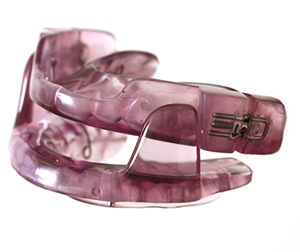Snoring occurs when the soft palate and soft tissues in the throat vibrate together. Like all muscles, the throat muscles relax during sleep, which reduces the size of the airway, and cause vibration on an in-breath.
In some cases, breathing stops altogether for a short time. This is called Obstructive Sleep Apnoea (OSA). All OSA sufferers snore but not all snorers have OSA.
A diagnosis of OSA is made when there are five or more abnormal respiratory events per hour, each lasting 10 seconds or longer. Abnormal events include “apnoeas” (breaks in breathing) and “hypopnoeas” (abnormal reductions in the depth and rate of breathing). As OSA can be a potentially life-threatening condition, a referral to a sleep clinic specialists might be recommended.
The shape and dimensions of the face and jaw determine whether people are likely to snore or suffer from OSA. Sufferers are likely to have a shorter lower jaw and an enlarged soft palate. Although the tongue size will probably be normal, it has less space in which to function.
Men are eight times more likely than women to suffer from OSA, though the gap narrows after menopause.
Most OSA events take place during the “rapid eye movement” (REM) phases of sleep. REM sleep is deep and refreshing and represents approximately a quarter of total sleep time. Loss of REM sleep might result in:

Depending on the severity, treatment for snoring or OSA could include:
Appliances are normally designed to pull the lower jaw and tongue forward, and thus make more space at the back of the throat. They are “mandibular advancement or positioning appliances”. We can offer treatment for both simple snoring and OSA.
To establish whether you have a simple snoring problem or OSA, others might also be involved. It will help to question your partner to find whether there are night-time episodes when your breathing stops. If there are, you might need to see a GP or a sleep clinic for assessment.